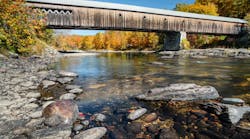The U.S. Environmental Protection Agency (EPA) and the U.S. Department of the Army have announced a final rule establishing a durable definition of “waters of the United States” (WOTUS).
EPA says that the definition will help reduce uncertainty from changing regulatory definitions, support health, and support economic opportunity.
The final rule restores essential water protections that were in place prior to 2015 under the Clean Water Act for traditional navigable waters, the territorial seas, interstate waters, as well as upstream water resources that significantly affect those waters.
“When Congress passed the Clean Water Act 50 years ago, it recognized that protecting our waters is essential to ensuring healthy communities and a thriving economy,” says EPA Administrator Michael S. Regan. “Following extensive stakeholder engagement, and building on what we’ve learned from previous rules, EPA is working to deliver a durable definition of WOTUS that safeguards our nation’s waters, strengthens economic opportunity, and protects people’s health while providing greater certainty for farmers, ranchers, and landowners.”
The new definition will become effective 60 days after it is published in the Federal Register.
“This final rule recognizes the essential role of the nation’s water resources in communities across the nation,” says Michael L. Connor assistant secretary of the army for civil works. “The rule’s clear and supportable definition of waters of the United States will allow for more efficient and effective implementation and provide the clarity long desired by farmers, industry, environmental organizations, and other stakeholders.”
Rulings over the last couple years have led to unstable ground for the definition of WOTUS. In 2020, the agencies had issued a rule under the Trump administration titled the Navigable Waters Protection Rule (NWPR), which moved away from prior regulations, diminishing the role of science in the Clean Water Act and providing less protection than the regulations preceding it.
In January 2021, the Biden administration directed federal agencies to review many regulations — including a review of the NWPR by EPA and the Army. The agencies then concluded that the NWPR didn’t provide a sufficient definition to protect many waters in the nation. EPA and the Army announced their intent to revise the WOTUS definition in June 2021.
In August 2021, the agencies stopped implementation the NWPR and re-established a pre-2015 definition that had been in place for decades.
Now, once the latest rule becomes effective, WOTUS might once again have a stable definition.
This rule establishes a durable definition of WOTUS that EPA says is grounded in the authority provided by Congress in the Clean Water Act, the best available science, and extensive implementation experience stewarding the nation’s waters.
The rule returns to a familiar framework founded on the pre-2015 definition with updates to reflect existing Supreme Court decisions, the latest science, and the agencies’ technical expertise. It establishes limits that draw the boundary of waters subject to federal protection.
To help support the implementation of the rule across the U.S., the agencies also released a summary of their regional roundtables, which provides key actions that the agencies promise to take to support the implementation.
The agencies also announced action to improve federal coordination in the ongoing implementation of “waters of the United States.” EPA and the Army are issuing a joint coordination memo to ensure the accuracy and consistency of jurisdictional determinations under the final rule. The agencies are also issuing a memo with U.S. Department of Agriculture to provide clarity on the agencies’ programs under the Clean Water Act and Food Security Act.






